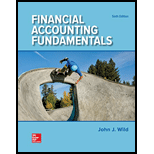
Financial Accounting Fundamentals
6th Edition
ISBN: 9781259726910
Author: John J Wild, Ken W. Shaw, Barbara Chiappetta Fundamental Accounting Principles
Publisher: McGraw-Hill Education
expand_more
expand_more
format_list_bulleted
Question
Chapter 10, Problem 8AP
1.
To determine
Prepare the
2.
To determine
Calculate the total bond interest expense that will be recognized over the life of the bonds.
3.
To determine
Prepare an amortization table for the first two years of the bonds using effective interest method to amortize the discount.
4.
To determine
Prepare the journal entry to record semiannual interest and amortization of discount on bonds.
Expert Solution & Answer
Want to see the full answer?
Check out a sample textbook solution
Students have asked these similar questions
Compute the company's predetermined overhead rate
Please explain the solution to this general accounting problem with accurate principles.
Don't use ai given answer accounting
Chapter 10 Solutions
Financial Accounting Fundamentals
Ch. 10 - Prob. 1MCQCh. 10 - Prob. 2MCQCh. 10 - Prob. 3MCQCh. 10 - Prob. 4MCQCh. 10 - Prob. 5MCQCh. 10 - Prob. 1DQCh. 10 - Prob. 2DQCh. 10 - Prob. 3DQCh. 10 - Prob. 4DQCh. 10 - Prob. 5DQ
Ch. 10 - Prob. 6DQCh. 10 - Prob. 7DQCh. 10 - Prob. 8DQCh. 10 - Prob. 9DQCh. 10 - Prob. 10DQCh. 10 - Prob. 11DQCh. 10 - Prob. 12DQCh. 10 - Prob. 13DQCh. 10 - Prob. 14DQCh. 10 - Prob. 15DQCh. 10 - Prob. 16DQCh. 10 - Prob. 17DQCh. 10 - Prob. 18DQCh. 10 - Prob. 19DQCh. 10 - Prob. 20DQCh. 10 - Prob. 1QSCh. 10 - Prob. 2QSCh. 10 - Prob. 3QSCh. 10 - Prob. 4QSCh. 10 - Prob. 5QSCh. 10 - Prob. 6QSCh. 10 - Prob. 7QSCh. 10 - Prob. 8QSCh. 10 - Prob. 9QSCh. 10 - Prob. 10QSCh. 10 - Prob. 11QSCh. 10 - Prob. 12QSCh. 10 - Prob. 13QSCh. 10 - Prob. 14QSCh. 10 - Prob. 15QSCh. 10 - Prob. 16QSCh. 10 - Prob. 17QSCh. 10 - Prob. 18QSCh. 10 - Prob. 19QSCh. 10 - Prob. 20QSCh. 10 - Prob. 1ECh. 10 - Prob. 2ECh. 10 - Prob. 3ECh. 10 - Prob. 4ECh. 10 - Prob. 5ECh. 10 - Prob. 6ECh. 10 - Prob. 7ECh. 10 - Prob. 8ECh. 10 - Prob. 9ECh. 10 - Prob. 10ECh. 10 - Prob. 11ECh. 10 - Prob. 12ECh. 10 - Prob. 13ECh. 10 - Prob. 14ECh. 10 - Prob. 15ECh. 10 - Prob. 16ECh. 10 - Prob. 17ECh. 10 - Prob. 18ECh. 10 - Prob. 19ECh. 10 - Prob. 20ECh. 10 - Prob. 1APCh. 10 - Prob. 2APCh. 10 - Prob. 3APCh. 10 - Prob. 4APCh. 10 - Prob. 5APCh. 10 - Prob. 6APCh. 10 - Prob. 7APCh. 10 - Prob. 8APCh. 10 - Prob. 9APCh. 10 - Prob. 10APCh. 10 - Prob. 11APCh. 10 - Prob. 1BPCh. 10 - Prob. 2BPCh. 10 - Prob. 3BPCh. 10 - Prob. 4BPCh. 10 - Prob. 5BPCh. 10 - Prob. 6BPCh. 10 - Prob. 7BPCh. 10 - Prob. 8BPCh. 10 - Prob. 9BPCh. 10 - Prob. 10BPCh. 10 - Prob. 11BPCh. 10 - Prob. 10SPCh. 10 - Prob. 1BTNCh. 10 - Prob. 2BTNCh. 10 - Prob. 3BTNCh. 10 - Prob. 4BTNCh. 10 - Prob. 7BTNCh. 10 - Prob. 9BTN
Knowledge Booster
Learn more about
Need a deep-dive on the concept behind this application? Look no further. Learn more about this topic, accounting and related others by exploring similar questions and additional content below.Similar questions
- Prada Manufacturing had a Work in Process balance of $72,000 on January 1, 2022. The year-end balance of Work in Process was $95,000, and the Cost of Goods Manufactured was $730,000. Use this information to determine the total manufacturing costs incurred during the fiscal year 2022.arrow_forwardCan you help me solve this general accounting problem using the correct accounting process?arrow_forwardThe basis of asingle overhead allocation rate based on direct labor hours?arrow_forward
- General accountingarrow_forwardIf the cost of the beginning work in process inventory is $92,000, costs of goods manufactured is $1,050,000, direct materials cost is $375,000, direct labor cost is $255,000, and overhead cost is $360,000, calculate the ending work in process inventory.arrow_forwardFinancial Accounting questionarrow_forward
arrow_back_ios
SEE MORE QUESTIONS
arrow_forward_ios
Recommended textbooks for you

 AccountingAccountingISBN:9781337272094Author:WARREN, Carl S., Reeve, James M., Duchac, Jonathan E.Publisher:Cengage Learning,
AccountingAccountingISBN:9781337272094Author:WARREN, Carl S., Reeve, James M., Duchac, Jonathan E.Publisher:Cengage Learning, Accounting Information SystemsAccountingISBN:9781337619202Author:Hall, James A.Publisher:Cengage Learning,
Accounting Information SystemsAccountingISBN:9781337619202Author:Hall, James A.Publisher:Cengage Learning, Horngren's Cost Accounting: A Managerial Emphasis...AccountingISBN:9780134475585Author:Srikant M. Datar, Madhav V. RajanPublisher:PEARSON
Horngren's Cost Accounting: A Managerial Emphasis...AccountingISBN:9780134475585Author:Srikant M. Datar, Madhav V. RajanPublisher:PEARSON Intermediate AccountingAccountingISBN:9781259722660Author:J. David Spiceland, Mark W. Nelson, Wayne M ThomasPublisher:McGraw-Hill Education
Intermediate AccountingAccountingISBN:9781259722660Author:J. David Spiceland, Mark W. Nelson, Wayne M ThomasPublisher:McGraw-Hill Education Financial and Managerial AccountingAccountingISBN:9781259726705Author:John J Wild, Ken W. Shaw, Barbara Chiappetta Fundamental Accounting PrinciplesPublisher:McGraw-Hill Education
Financial and Managerial AccountingAccountingISBN:9781259726705Author:John J Wild, Ken W. Shaw, Barbara Chiappetta Fundamental Accounting PrinciplesPublisher:McGraw-Hill Education


Accounting
Accounting
ISBN:9781337272094
Author:WARREN, Carl S., Reeve, James M., Duchac, Jonathan E.
Publisher:Cengage Learning,

Accounting Information Systems
Accounting
ISBN:9781337619202
Author:Hall, James A.
Publisher:Cengage Learning,

Horngren's Cost Accounting: A Managerial Emphasis...
Accounting
ISBN:9780134475585
Author:Srikant M. Datar, Madhav V. Rajan
Publisher:PEARSON

Intermediate Accounting
Accounting
ISBN:9781259722660
Author:J. David Spiceland, Mark W. Nelson, Wayne M Thomas
Publisher:McGraw-Hill Education

Financial and Managerial Accounting
Accounting
ISBN:9781259726705
Author:John J Wild, Ken W. Shaw, Barbara Chiappetta Fundamental Accounting Principles
Publisher:McGraw-Hill Education
Financial Accounting - Long-term Liabilities - Bonds; Author: Finance & Accounting Videos by Prof Coram;https://www.youtube.com/watch?v=_1fwsJIGMos;License: Standard Youtube License